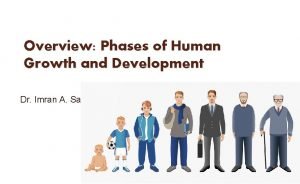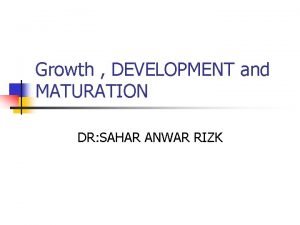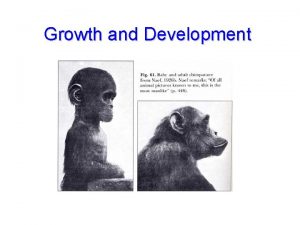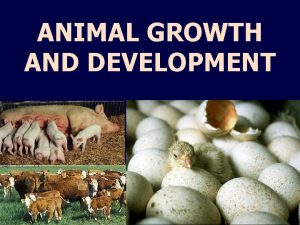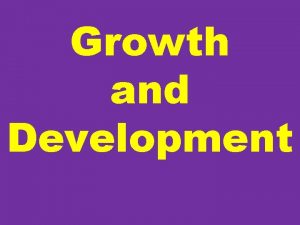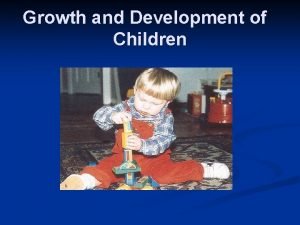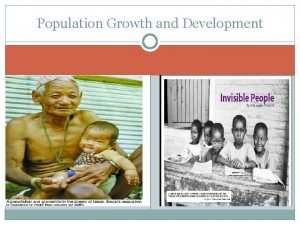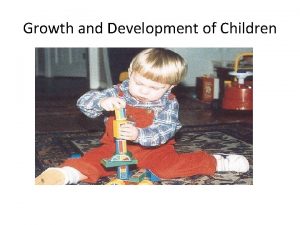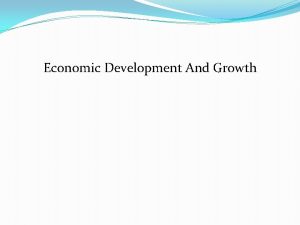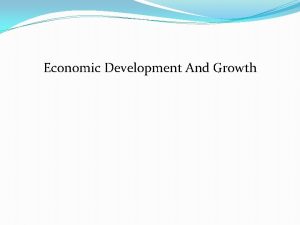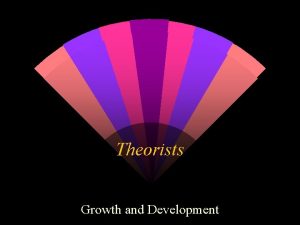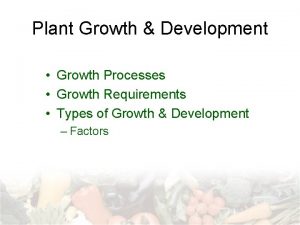Economics an introduction Growth and Development Growth Economics

















- Slides: 17

Economics: an introduction Growth and Development Growth Economics Roberto Pasca di Magliano 2015/2016

Origins of Liberalism: Adam Smith • The father of liberalism is considered Adam Smith who published in 1776 “The Wealth of Nations”, the birth of modern economics • Smith’s theories designed the modern economic thought by discovering the superiority of the free market over any other structure • Among the many ideas put forward by Smith, one was particularly successful: that of the famous metaphor of the “invisible hand”

The « Invisible Hand » • The metaphor of the invisible hand is the basis of the liberal view of the market economy • The market (as if it were guided by an invisible hand), if left free to operate according to its own rational logic, produces an unexpected result that is also desirable at the same time: it maximizes the wealth of the entire society • Such a result is reached without anyone explicitely pursuing a collective goal. Rather, the collective goal is reached thanks to the selfishness of individuals

Consequences of the free market • The consequence of such an assumption is all too obvious: the market works well only if it is left free (hence the famous expression “laissez faire”) • Therefore, the market, not only does not need any help, but if anything, just needs to be freed of obstacles and regulations that might prevent its action • It is interesting to note that in this last consideration, one can find an argument that is often made in favour of the market, even nowadays: the market must be left free, it must not be caged

The role of the State in the economy • The founder of theory of the role of the State in the market is John Maynard Keynes, who published in 1936 “General Theory of Employment, Interest and Money” • The innovative idea is that the role of the State is fundamental. Indeed, the market can, according to Keynes, produce results that are not optimal, and the State’s role is to help the market • The duty of the State is on the one hand to mitigate and control the economic cycles and on the other hand to bring the market to a better situation (especially in terms of unemployment) than the one that the market itself would have been able to realize if operating alone

Current Schools of Thought • Liberalism – monetarists – neo-classical school • State intervention – keynesian school – neo-keynesian school

Intermediate Positions (1) In reality, the contrast between market and State is played within the realm comprised between the two extreme positions, most radical in their nature. Hereafter are a few examples: • Antonio Martino pure liberal and intellectually close to the School of Chicago and to his most notable inspiration Milton Friedman, he trusts the free market as a source of economic and social progress • Jagdish Bagwati considers economic integration as positive, provided that the distortions be corrected without introducing duties • Anthony Giddens considers that the growing liberalization creates problems that globalization may, instead, contribute to solve • Lawrence Summers considers that, within the market, the State must insure the reduction of inequalities through fiscal harmonization

Intermediate Positions (2) • Amartya Sen & Peter Singer view risks but also positive opportunities in the market dynamics, underlining the necessity for regulation that bring businesses and individuals towards a virtuous path • Joseph Stiglitz argues in favour of the importance of the role, not only of the national State but also of the international institutions in regulating the market • Edward Luttwak & Giulio Tremonti underline the risks that the global market, if it is not properly regulated, might impose upon the workers of the developed world (low salaries, unemployment) and upon the environment • John Gray does not believe that the anglo-saxon model of economic liberalism can be applied to systems that are different from the western one historically speaking and advocates for national solutions • Paul Krugman (2008 Nobel Prize) underlines the need for global governance to make markets work, and that it be entrusted to the IMF

The market in the face of crisis Origins of the financial crisis 2007/08 • Since the 1980 s, liberal pressures and the dissemination of new and revolutionary communication technologies have produced an enormous expansion of the financiary activities at the international level • This has been, on the one hand, one of the cornerstones of globalization but on the other it has also brought about the huge expansion of a market that is less stable and less predictable than the real markets • From the 1970 s to the 1990 s, the volume of trade grew exponentially: suffice it to say that since the early 80 s to the mid 90 s, the trade volume produced by mutual funds, pension funds and institutional investors has increased tenfold • The conjunction between the expansion of financial wealth, the introduction of new derivative contracts and the growth of the debts of advanced countries has led to finance taking over the real economy. These phenomena are at the origin of the widespread crisis exploding in 2011, slowing down the global economic growth, causing recession and unemployment.

Financial Markets • They move volumes of wealth built on the trade of derivatives and other products that are detached from economic activities, whereby every turbulence generates psychological repercussions not only on the stock markets but also on the loans to businesses • They are maneuvered by investment banks and big investors, but are a cause of growing concern for the small savers • They are particularly volatile, and above all, moody: perceptions of the market compared to hypothetical scenarios may give rise to chain reactions • They influence real activities through banks and other financial intermediaries

Reasons of the actual crisis • Many have denounced the end of a financial system exempt of rules of supervision and surveillance • On the other hand, the same liberal view, while it encourages private activity, also places it in a balanced interaction between market and institutions • The present crisis originates in a guilty lack of governance, representative of the liberal culture that was indulged in during the times in which the strong economic growth facilitated financial activities (Fed, Grennspan) • But investment banks, and not only, have taken advantage of this, thrusting on much higher leverage ratios than those of the commercial banks, eventually bringing about the creation of high -risk financial products

The actual crisis: potential solutions Ø Public participation in the capitals of banks in crisis, provided it goes to fuel the loan supplies (EU’s approach) Ø Government guarantee both on deposits and interbank loans Ø Lighten the regulatory capital requirements of Basel 2 Ø Appeal to FDI by promoting cooperation agreements with Sovereign Funds Ø Greater flexibility in the budgetary constraints imposed by the Maastricht Treaty, revising a view that is only concerned with budgetary discipline and inflation Ø Boost the demand, by reducing the tax burden on families, in order to send a strong signal to the recovery of purchasing power Ø Review the rules regulating the financial and stock markets in order to fight the speculative designs that preceed the speculation in real terms over the economic and patrimonial consistency of businesses Ø Lower the minimum requirement for OPA in businesses to avoid hostile participations Ø Intervention of the European Stability Mechanism (ESM)

The differences between DEVELOPMENT & GROWTH Development: • newly-born backward countries after World War II • development is a four-leg chair where institutional, social, civil and economic aspects are stabilised • interdisciplinary studies Growth: • dominance of the economy over the behavior of institutions and individuals Main aspects: • explaining why growth is concentrated in a few countries, while many others are still waiting along the road • explaining how some developing countries are redeemed and crowding the group of the emerging countries • Explaining the dynamics that move the transition countries

Course-outline ØElements of development as part of classic economic litterature ØNotes on the newly-born specialized litterature on the basis of the success-experience of developing countries, distinct from the traditional litterature that has been denominated “growth theory” , by reviewing the most famous authors (Rostow, Myrdal, Lewis, Streeten, Sen, . . ) ØGrowth acceleration as the engine of national wealth and of the well-being of populations: Theories and models, both neoclassic and keynesian ØEndogenous growth theories, based on human capital valorization

Course-outline in details ØFrom theories to models ØClassical theories of development ØThe Keynesian growth model of Harrod-Domar ØNeo-classical models of growth: Solow approach ØAnalysis of growth based on the production function ØThe new endogenous growth theory (NTC) and macrodeterminants of growth

Changes in the world GDP

Income inequalities through the world The Gini coefficient is a number between 0 and 1, where 0 corresponds with perfect equality (where everyone has the same income) and 1 corresponds with perfect inequality (where one person has all the income—and everyone else has zero income). Income distribution can vary greatly from wealth distribution in a country.
 Economics and business economics maastricht
Economics and business economics maastricht Plant growth index
Plant growth index Ground tissue
Ground tissue Primary growth and secondary growth in plants
Primary growth and secondary growth in plants Vascular ray
Vascular ray Stages of human growth and development pictures
Stages of human growth and development pictures Theories on growth and development
Theories on growth and development Stages of human development
Stages of human development Social development in adulthood
Social development in adulthood Pretest: growth, development, and sexuality
Pretest: growth, development, and sexuality Growth development maturation
Growth development maturation The stages of growth and development
The stages of growth and development Slidetodoc.com
Slidetodoc.com What is economic growth and development
What is economic growth and development Domain 7
Domain 7 Growth and development pictures
Growth and development pictures Middle childhood growth and development
Middle childhood growth and development Distinguish between growth and development
Distinguish between growth and development







